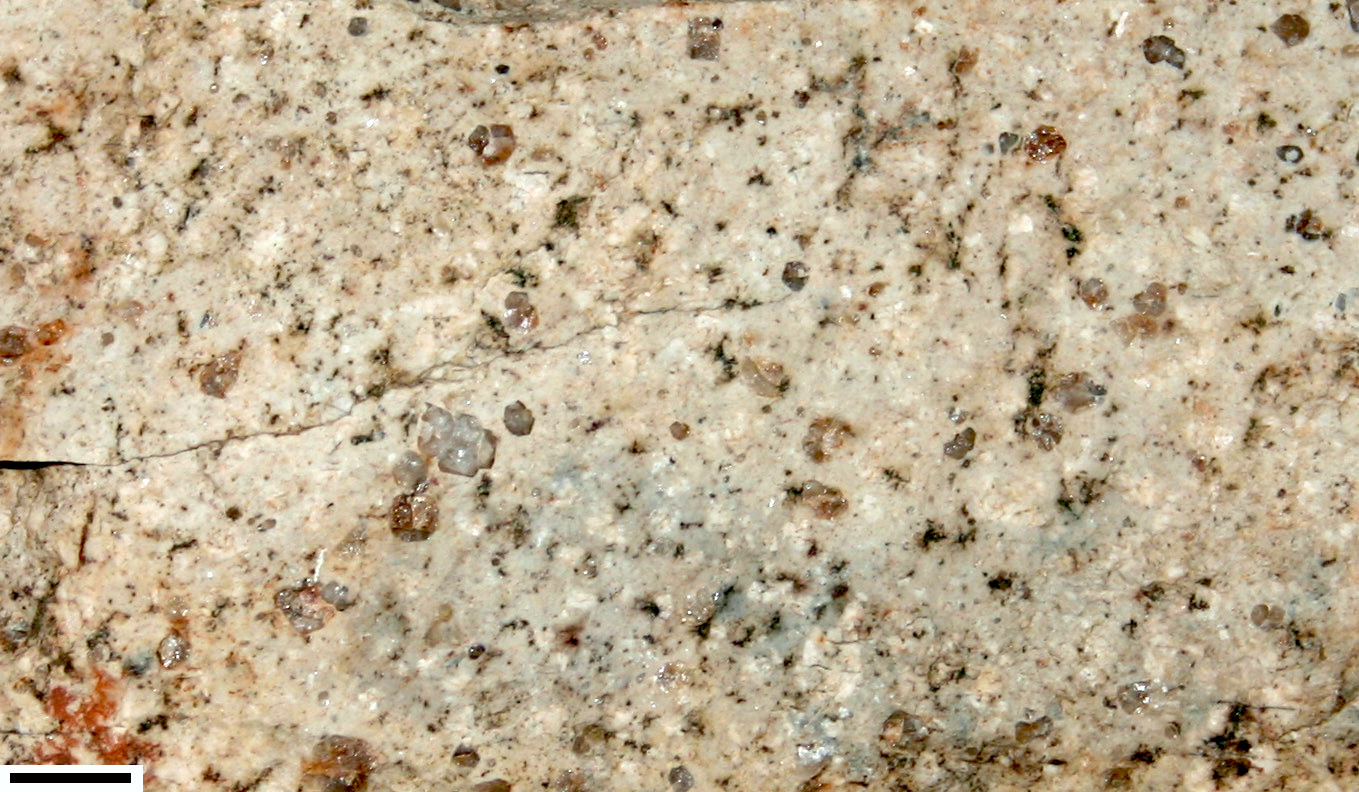Fountain Square is Cincinnati’s most famous landmark. Its centerpiece, the Tyler Davidson Fountain, was dedicated in October 1871. The metallic portion was cast in Munich, Germany; the bronze came from Danish cannon. The rim of the basin and the base of the fountain are Bavarian porphyry, a dark-brownish-blue igneous rock that has large crystals (phenocrysts) in a finer matrix. The stone was quarried and polished in Bavaria, Germany.
Porphyry is a textural term for an igneous rock consisting of large-grained crystals such as feldspar or quartz dispersed in a fine-grained silicate rich, generally aphanitic matrix or groundmass. The larger crystals are called phenocrysts. In its non-geologic, traditional use, the term porphyry refers to the purple-red form of this stone, valued for its appearance.

Porphyry deposits are formed when a column of rising magma is cooled in two stages. In the first, the magma is cooled slowly deep in the crust, creating the large crystal grains with a diameter of 2 mm or more. In the second and final stage, the magma is cooled rapidly at relatively shallow depth or as it erupts from a volcano, creating small grains that are usually invisible to the unaided eye.
How does pitting occur? A water molecule has a very simple chemical formula, H2O, two hydrogen atoms bonded to one oxygen atom. But water is pretty remarkable in terms of all the things it can do. Water is a polar molecule; the positive side of the molecule attracts negative ions and the negative side attracts positive ions. So water molecules separate the ions from their compounds and surround them. Water can completely dissolve some minerals, such as salt.
Hydrolysis is the name of the chemical reaction between a chemical compound and water. When this reaction takes place, water dissolves ions from the mineral and carries them away. These elements have undergone leaching. Through hydrolysis, a mineral such as potassium feldspar is leached of potassium and changed into a clay mineral. Clay minerals are more stable at the Earth’s surface.
Pitting and fissures - When a stone is polished along one plane, pitting and fissuring is inevitable. Because the multiple crystals are oriented in different directions, the interstices between the crystals always show some sign where the polishing plane has cut through the natural breakage lines. Sometimes, due to the heating and cooling of the rock after its formation, these fissures are more obvious than others, but they are rarely completely absent. The pits are in effect tiny spaces between the various mineral crystals; they do not represent structural defects in the stone. Occasionally whole crystals may break out of the surface during polishing, and various techniques are used to mimimize the frequency and effects of this.
As water enters these pits, more weathering and erosion can occur. Water can enlarge the existing pits and even create new ones. If the stone is developing small pits or small pieces of stone are popping off the surface (spalling) then you have a problem. This condition is common on stone exposed to large amounts of water or when deicing salts are used for ice removal. Like efflorescence, mineral salts are the cause for spalling and pitting. Instead of the salts depositing on the surface (efflorescence) they deposit below the surface of the stone, causing pressure within the stone and therefore the stone spalls, flakes or pits. Unfortunately once a stone begins to spall it is almost impossible to repair.
Please send the following answers to my account to get credit for the earthcache:
1. In your own words, explain how pitting occurs.
2. Are the pits the same size or different sizes?
3. Do you see any evidence of efflorescence?
4. Where do you see more pitting occuring, a) where the water touches the fountain, or b) outside part of fountain?
4. Post a picture of yourself (face not required) or a personal item at the fountain.
sources: Wikipedia, Geology.com and OSU